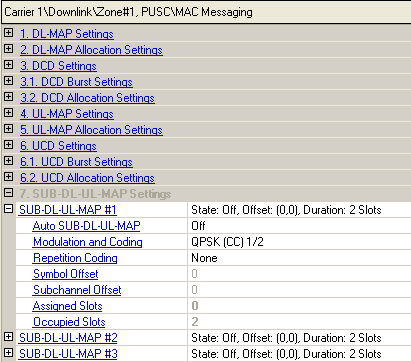 to the left of each Sub-DL-UL-MAP to access
the settings for that item. The Sub-DL-UL-MAPs are all placed in the first
DL-PUSC zone, MAC Messaging to simplify the setup.
to the left of each Sub-DL-UL-MAP to access
the settings for that item. The Sub-DL-UL-MAPs are all placed in the first
DL-PUSC zone, MAC Messaging to simplify the setup.
Sub-DL-UL-MAPs can only be used with the compressed
MAPs. They are not used with the normal DL-MAP or UL-MAP. Up to three
Sub-DL-UL-MAPs may be enabled. Click  to the left of each Sub-DL-UL-MAP to access
the settings for that item. The Sub-DL-UL-MAPs are all placed in the first
DL-PUSC zone, MAC Messaging to simplify the setup.
to the left of each Sub-DL-UL-MAP to access
the settings for that item. The Sub-DL-UL-MAPs are all placed in the first
DL-PUSC zone, MAC Messaging to simplify the setup.
By default, the IE for all data burst are placed in the DL-MAP or UL-MAP as appropriate. To specify which Sub-DL-UL-MAP the burst IE will be placed, click the Zone and go the burst table. The last column allows you to specify whether that burst IE should go into a Sub-DL-UL-MAP, and if so, which Sub-DL-UL-MAP it will go into. Note that you still need to enable that Sub-DL-UL-MAP separately in the MAC Messaging setup.
All the UL-MAP-IEs in one SUB-DL-UL-MAP should come from a single uplink zone. If IE in Sub-Map properties of two or more bursts from different uplink zones are pointed to the same SUB-DL-UL-MAP, an error message will be displayed in the status bar.
The SUB-DL-UL MAP can only be applied when DL-MAP and UL-MAP are set to compressed.

Choices: On, Off
Use the drop-down menu or double-click to turn Auto SUB-DL-UL-MAP on or off. Turn Auto SUB-DL-UL-MAP on to automatically generate a SUB-DL-UL-MAP message and allocate a burst for it. The burst allocation is immediately below the compressed DL-UL-MAP, and has a one-dimensional subchannel axis.
Select the modulation type, coding type, and coding rate from the drop down menu. The type of coding available depends on the burst profile.
RAW – data is mapped to the OFDMA user carriers without any randomizing, encoding, or interleaving.
CC – data is randomized, encoded using convolutional coding, and interleaved according to the standard specifications.
CTC – data is randomized, encoded using convolutional turbo coding, and interleaved according to the standard specifications.
Choices: None, 2, 4, 6
Select the number of times the coded or uncoded data is repeated. Repetition coding is only available when QPSK 1/2 or QPSK 3/4 is selected for the burst profile (Rate ID).
Displays the starting symbol offset of the SUB-DL-ULMAP burst. (Read-only)
Displays the starting subchannel offset of the SUB-DL-UL MAP burst. (Read-only)
Displays the total available  slots
in this burst based on the number of symbols times the number of subchannels
selected.
slots
in this burst based on the number of symbols times the number of subchannels
selected.
Displays how many  slots
are needed for the burst based on the total length in bytes of all MAC
PDUs. It also depends on the rate ID and coding type selected for each
burst.
slots
are needed for the burst based on the total length in bytes of all MAC
PDUs. It also depends on the rate ID and coding type selected for each
burst.
In SUB-DL-UL-MAP configuration, Occupied Slots, Symbol Offset and Subchannel Offset are read-only and determined by auto allocation. 'Assigned Slots' is configurable when 'Auto Allocation' of the first downlink PUSC zone is turned off.